MIDDLETOWN, MD – One nice thing about booking reservations with a well-known hotel chain is, you know what to expect -- which is similar to the knowledge employed when making tee times at your favorite golf courses. |
|
If you’re longing for a basic par three with crusty mats for tee boxes and greens resembling a bombed-out WW II runway, that’s a ‘Motel 6’ course. If you want an essentially flat muni with a full length, comfortable, ‘no frills’ layout, that’s a ‘Days Inn.’ If you desire an upscale course with pretty good service, a well thought out routing sequence and better than average conditions, that’s a ‘Sheraton’-type facility. But if you crave the best of everything, the crème de la crème of outings, you’re looking for a ‘Ritz-Carlton’ golf experience.
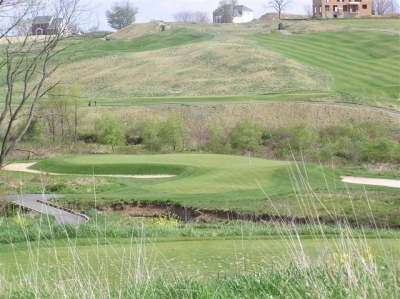 |
| Don't go island hopping on the par three 17th hole, or you'll end up in the wetlands. |
That’s what you’ll get at the Arthur Hills designed Maryland National Golf Club in Middletown, Maryland. Mike McGillicuddy, the club’s General Manager/Director of Golf, elaborates: “Our goal since the beginning (the club opened in late June of 2002) has been to give our players the best golf experience they’ve ever had – and everything is geared towards that. Our clubhouse, practice facilities, GPS system and service is devoted to that objective.”
“I’m not going to say it’s ‘a country club for a day,’ because that term’s been used over and over again. But we want to be the Ritz-Carlton of the golf industry in this area. We want people to feel like they’ve just visited a very special place, and they’ll want to go back and play it again,” McGillicuddy added.
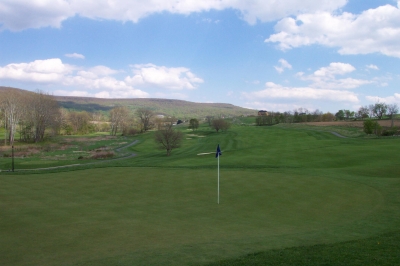 |
| The 13th and 15th fairways run parallel to each other, providing plenty of room to miss on both holes. |
We’ve been back to play Maryland National several times since its initial opening, and we’re happy to report, each time it’s gotten better. Because of the up and down rolls in the land, the golf course will always offer plenty of difficulty. McGillicuddy said they’ve assessed the playability situation on several different occasions, and made some changes accordingly.
They’ve trimmed the tall grass areas bordering some particularly problematic holes, eliminating the ill effects of blind shots and potential bad bounces. They’ve widened the 16th hole, making it a more enticing risk-reward opportunity, and they’ve cut down some of the vegetation in the creek beds (complying with environmental regulations, of course) to aid with visibility.
The club itself took awhile to build, but it was worth the wait. McGillicuddy explains why: “Construction was delayed a couple years because one of our owners, Tate DeWeese, was pursuing a lifelong dream of owning a minor-league baseball team (The Altoona Curves). But back in 1999, things began falling into place with our ownership group – and Mr. Hills was brought back to lend his touch to the land. The end result being, our beautiful golf course.”
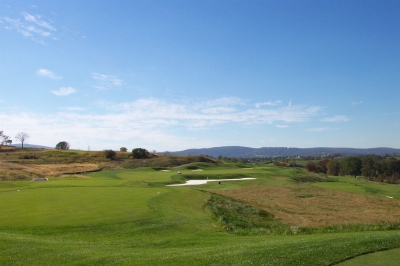 |
| The 426 yard par four 11th hole is one that was 'benched' into the hillside to make it playable. |
Beautiful indeed. There are several excellent golf courses in the Frederick area, all of which have opened in the last half-decade and change. Maryland National just might be the ‘biggest hitter’ on the block, though -- but that’s certainly not a knock against its close siblings in the region. It’s a tribute to what you’ll find in this unpretentious part of central Maryland – mainly, some truly incredible golf.
The scenery is second-to-none, as the land’s rolling topography eases towards the horizon. Most people probably associate the Mid-Atlantic with its cities, Washington DC, Baltimore or Philadelphia, but it’s places like Maryland National that comes to mind when I think of the region.
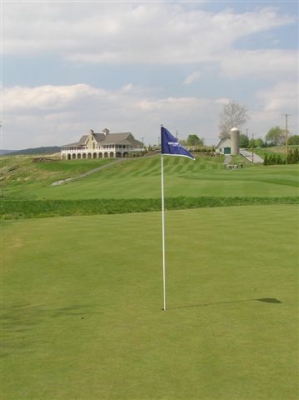 |
| Looking back from the short par four 10th hole, you'll see the clubhouse in the background. |
This thought also seems to have struck Arthur Hills: “To me, the thing that really stood out about Maryland National was the beauty and variation of the ground. It was mainly two big long sloping hillsides, which had primarily been used for pasturing livestock. The property also contained a pretty stream running down the middle of it, some wetlands, and a little area with some nice trees on it. It had all the elements of a pretty exacting golf course, but we softened it up a bit by ‘benching’ in some holes out of the slopes.”
“And we also had an excellent shaper (Tim Furness) on the project. We’d worked with him up at Bay Harbor in Michigan, and his people really did a great job. Having a good rapport with the shaper always helps. They really interpreted our drawings in a dramatic way,” Hills said.
That may be an understatement. Drama’s the word from the moment you step to the first tee and notice what looks like a mile-wide fairway bisected by a pair of bunkers (the first and fifth fairways actually lie right next to each other, but your ball’s playable from either unless you hit one so bad you’ll be too embarrassed to look for it).
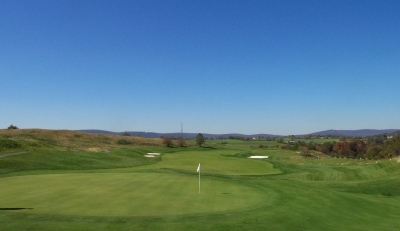 |
| The par four 4th hole is long and difficult as it is -- and the day we played, it was into the wind. |
Maryland National’s drama continues throughout the course with wide fields of green (mostly wide, at least), bordered by the previously referenced native grasses, wetlands and surrounded by incredible scenery. The greens (in typical Hills’ style) are small and traditionally undulating, the sculpted bunkering is attractive to the eye, yet not overstated. And there are only a few carries that’ll worry you.
What isn’t evident until you complete all eighteen holes is the variety Maryland National offers. Hills talks about diversity in his design philosophies: “I really like to include a little tiny par four like the 16th hole (336 yards), someplace in our routing. It’s the kind of a hole where you can make a low score, but you also might end up making a high score. You won’t always find good ground for it, but when you do, I like to put one there.”
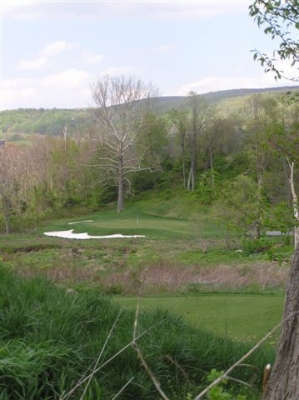 |
| From the tee of the par three 14th hole. The tall vegetation was cut down in front of the green, and now you can see the bunker. |
Hills continues, “We normally have two or three lengthy par fours on the course, like numbers four and eight (426 and 468 yards, respectively). Then a short par three like fourteen (190 yards and downhill), and a short par five, which will be maybe a drive and an iron. We also like small greens. And every shot should be a strategic situation, so there’s a risk-reward type of decision on virtually every occasion.”
Maryland National’s 6811 yard, par 71 layout doesn’t really need beastly long holes to be creative and challenging. As alluded to above, it’s got a little of everything. McGillicuddy says, “You have open holes where you can hit it off the planet and still find it. And you’ve got some holes, like our par threes, where if you miss the green, you’re dead. You’ve got links-style holes, and you’ve got some cut through stands of hardwoods. The par threes are the best set of one shotters I’ve ever played.”
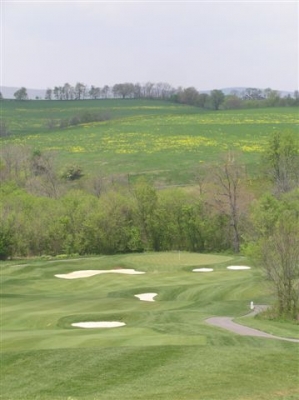 |
| It's all downhill to the par five 2nd hole -- but as you can see, it's well bunkered, too. |
“When you put the whole thing together, for a course management player thinking about playing this golf course, you’ll enjoy playing it time and again – and really give a lot of thought as to where you place the ball, because the golf course plays a lot differently when you hit the ball in the right places,” McGillicuddy said.
Those small greens really run quick, too. McGillicuddy said they’re rolling between 10 – 10 ½ on the stimpmeter. They’re also undulated, so you rarely have a dead straight putt. A thorough challenge.
One other note about the design – it sheds glances of ancient and traditional courses across the sea. Our playing partner, Sol Gordon, said the mounding fronting several of the greens reminded him of playing in Ireland (speaking specifically of holes seven, nine and eleven). Though the mounds make the shots partially blind, with the GPS system, you’re still never firing into the dark.
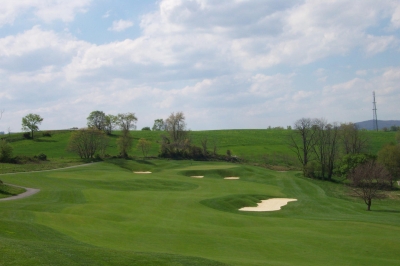 |
| The par five 13th hole presents many different options on how to play it. One thing is standard -- great natural beauty. |
Highlights are hard to extract from a course with so many, but the second hole deserves special note. One of the few blind tee shots on the course, nevertheless the landing area is very wide and you’ll get some great roll down the slope if you hit it long enough. Definitely reachable even at 567 yards, it’s the ‘short’ par five Hills talked about above.
Six is a tremendous par three. 210 yards from the back, it plays downhill to a green guarded by two huge sycamore trees in back and to the side, and a stream to the front. This green is one of the bigger targets on the course, but remind yourself of that with club in hand standing on top of the hill!
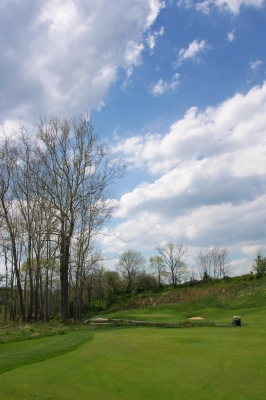 |
| The short par four 16th hole was redone in recent times, opening up both the left and right sides to make it play a little friendlier. |
The back nine is every bit as spectacular as the front side (if not more). Favorites included thirteen, a strategic par five that plays downhill from the tee, then back up the slope to reach the green. The hole’s as beautiful as it is clever – one you won’t forget.
As mentioned above, the sixteenth hole’s (336 yard, slight dogleg left par four) been changed since the last time we visited – and it’s definitely an improvement: “We made the changes for two reasons,” McGilicuddy lectured. “First, we needed to improve the turf conditions. That hole is tucked in amongst the trees in a small valley, and there’s a cliff on the right side – so there wasn’t enough air circulation. Then, while we were thinning out the trees on the left side, we decided to take down a couple of the big ones that affected the playability of the tee shot. It’s still a difficult shot to try and go at the green from the tee, but now we think it encourages people to try it, whereas before it was almost impossible.”
McGillicuddy says seventeen (206 yard par three) is probably the hole everyone will leave thinking about: “Standing over that tee shot on seventeen and looking down at, for all intents and purposes an island green, it’s both stimulating and intimidating. Wetlands border the long and right sides, so your only option is to miss short, and to a lesser extent, left – and not attractive options at that, with the large bunker that wraps around the front and left sides.”
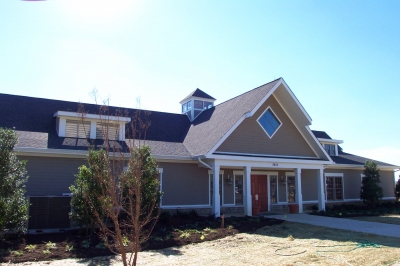 |
| The Maryland National Clubhouse has over 14,000 square feet of capacity -- they'll save some of it for you. |
One final departure from our initial visit to Maryland National is the finished clubhouse. At just over 14,000 square feet, it’s got a full service pro shop, a 120 seat tavern, space for business meetings and state-of-the-art audio visual capability. There’s also a deck from which you can take in all that is the beauty of this scenic part of the State of Maryland.
To sum up, the course may provide some scary choices in the golf sense, but you’ll probably remember the challenges more than the failures. Maryland National definitely deserves high placement amongst the DC area’s best public courses. Remember that the next time you’re seeking the ‘Ritz-Carlton’ of the golfing world.
Details:
Maryland
Phone: (301) 371-0000
FAX: (301) 371-0020
Course Designer:
General Manager/Director of Golf: Mike McGillicuddy
Head Golf Professional: Mike McGillicuddy
Director of Sales and Marketing: Jason Wirtz
Website: http://www.marylandnational.com
Tees/Yardage/Rating/Slope
Black 6811 73.1 137
Gold 6504 71.8 135
White 6038 69.6 132
Green 5484 67.2 119
Red 4884 68.3 120
Rates:
2005 rates are as follows:
$69 Monday - Thursday, $49 twilight
$79 Friday, $59 twilight
$89 Sat/Sunday, $74 at 12:00, $59 twilight rate
*Currently "twilight" is 4:00 but that is subject to change as darkness comes earlier
* All fees include greens fees, cart fees, GPS and use of practice facility for day of play. Reservations may be made up to 14 days in advance.
Traditional golf attire is required (collared shirts, bermuda shorts, no denim). Metal spikes prohibited.
Membership Program is available for weekday play. Contact Jason Wirtz for information.
Walking is permitted for members only.
| Related Links | Comments on this article? | |
|
Maryland National Golf Club Hollow Creek Golf Club Rocky Gap Resort PB Dye Golf Club in Ijamsville Whiskey Creek Golf Club |
E-mail Jeff Rendall, Editor: jrendall@golftheunitedstates.com |













